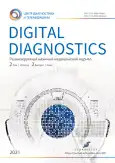Long-term broncocele anamnesis, triggered by typical carcinoid
- Authors: Prusakova K.V.1, Gavrilov P.V.1
-
Affiliations:
- Saint-Petersburg State Research Institute of Phthisiopulmonology
- Issue: Vol 2, No 2 (2021)
- Pages: 223-230
- Section: Case reports
- URL: https://journals.rcsi.science/DD/article/view/70922
- DOI: https://doi.org/10.17816/DD70922
- ID: 70922
Cite item
Abstract
The paper presents a case of a single bronchocele (bronchogenic retention cyst) caused by a typical carcinoid that was observed for a long time. During the initial complex examination, including computed tomography with intravenous contrast, fibrobronchoscopy, and immunological and bacteriological examinations of tuberculosis, there were no changes for the oncological and infectious nature. The changes were interpreted as the result of a postponed nonspecific inflammatory process. Most of them were monitored using chest X-ray and the changes were stable. After 15 years, a control chest X-ray revealed an increase in the size of the compaction in the lung and the appearance of a mass with calcification in the medial sections of the compaction zone. Additional examination, including computed tomography with biopsy, determined that the obstruction of the bronchus was caused by a neoplasm [according to histological examination (typical carcinoid)].
It should be noted that the initial detection of negative study results requires oncological alertness and periodic examinations in dynamics.
Keywords
Full Text
##article.viewOnOriginalSite##About the authors
Ksenia V. Prusakova
Saint-Petersburg State Research Institute of Phthisiopulmonology
Email: ksenya.rush@mail.ru
ORCID iD: 0000-0002-3934-6290
clinical resident specializing in radiology
Russian Federation, 2-4, Ligovskiy pr., Saint-Petersburg, 191036Pavel V. Gavrilov
Saint-Petersburg State Research Institute of Phthisiopulmonology
Author for correspondence.
Email: spbniifrentgen@mail.ru
ORCID iD: 0000-0003-3251-4084
MD, Cand. Sci. (Med.)
Russian Federation, 2-4, Ligovskiy pr., Saint-Petersburg, 191036References
- Hansell DM, Bankier AA, MacMahon H, et al. Fleischner Society: glossary of terms for thoracic imaging. Radiology. 2008;246(3):697–722. doi: 10.1148/radiol.2462070712
- Martinez S, Heyneman LE, McAdams HP, et al. Mucoid impactions: finger-in-glove sign and other CT and radiographic features. Radiographics. 2008;28(5):1369–1382. doi: 0.1148/rg.285075212
- Nguyen ET. The gloved finger sign. Radiology. 2003;227(2):453–454. doi: 10.1148/radiol.2272011548
- Farrell C, Goggins M, Casserly M. Unexpected diagnosis resulting from presentation with chronic obstructive pulmonary disease (COPD) exacerbation. International Journal of Case Reports and Images. 2019;43–47. doi: 10.36811/jcri.2019.110007
- Kulkarni GS, Gawande SC, Chaudhari DV, Bhoyar AP. Bronchial carcinoid: case report and review of literature. MVP J Med Sci. 2016;3(1):71–78. doi: 10.18311/mvpjms/2016/v3/i1/740
- Yadav V, Rathi V. Bronchial carcinoid with bronchocele masquerading as Scimitar syndrome on chest radiograph. Radiol Case Rep. 2021;16(3):710–713. doi: 10.1016/j.radcr.2021.01.013
- Jeung MY, Gasser B, Gangi A, et al. Bronchial carcinoid tumors of the thorax: spectrum of radiologic findings. Radiographics. 2002;22(2):351–365. doi: 10.1148/radiographics.22.2. g02mr01351
- Paladugu RR, Benfield JR, Pak HY, et al. Bronchopulmonary Kulchitzky cell carcinomas. A new classification scheme for typical and atypical carcinoids. Cancer. 1985;55(6):1303–1311. doi: 10.1002/1097-0142(19850315)55:6<1303:aid-cncr2820550625>3.0.co;2-a
- Grote TH, Macon WR, Davis B, et al. Atypical carcinoid of the lung. A distinct clinicopathologic entity. Chest. 1988;93(2):370–375. doi: 10.1378/chest.93.2.370. PMID: 2827965
- Harpole DH, Feldman JM, Buchanan S, et al. Bronchial carcinoid tumors: a retrospective analysis of 126 patients. Ann Thorac Surg. 1992;54(1):50–54; discussion 54-5. doi: 10.1016/0003-4975(92)91139-z
- Kuznetsov NS, Latkina NV, Dobreva EA. ACTH-ectopic syndrome: clinic, diagnosis, treatment. Endocrine surgery. 2012;6(1):24–36. (In Russ).
- Buryakina SA, Karmazanovsky GG, Volevodz NN, et al. CT-signs of neuroendocrine lung tumors and their relationship with ACTH-ectopic syndrome. REJR. 2018;8(4):56–72. (In Russ). doi: 10.21569/2222–7415-2018-8-4-56-72
- Trachtenberg AH, Kolbanov KI, Frank GA, et al. Features of diagnosis and treatment of lung carcinoid tumors. Atmosphere. Pulmonology and allergology. 2009;(1):2–6. (In Russ).
- Raz DJ, Nelson RA, Grannis FW, Kim JY. Natural history of typical pulmonary carcinoid tumors: a comparison of nonsurgical and surgical treatment. Chest. 2015;147(4):1111–1117. doi: 10.1378/chest.14-1960
- Kaifi JT, Kayser G, Ruf J, Passlick B. The diagnosis and treatment of bronchopulmonary carcinoid. Dtsch Arztebl Int. 2015;112(27-28):479–485. doi: 10.3238/arztebl.2015.0479.
Supplementary files













